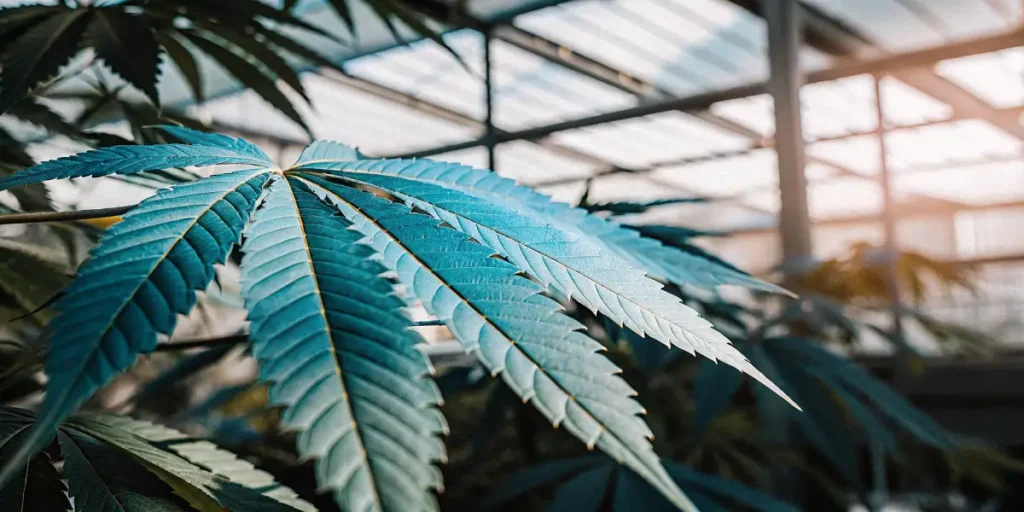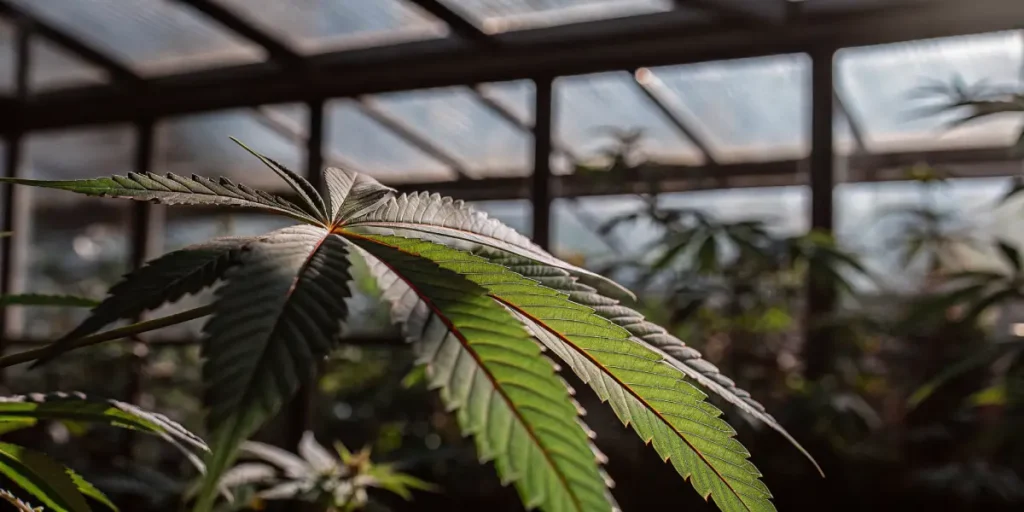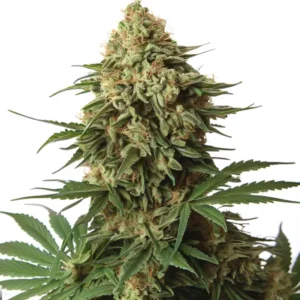
Nitrogen Mobility in Cannabis Plants
Nitrogen is crucial for cannabis plants. It’s the building block for amino acids, the proteins that power growth. Without it, plants can’t produce the chlorophyll they need for photosynthesis. But how does nitrogen move through a cannabis plant? That’s what we call nitrogen mobility in cannabis plants.
When you grow cannabis, you want to ensure nitrogen moves effectively from roots to leaves. This movement is essential because it supports the plant’s overall health. If nitrogen isn’t mobile, plants can develop yellowing leaves, a sign of nitrogen deficiency symptoms in cannabis plants.
Recommended Strains
Chemdog #4
|
|
THC | 18% - 26% (Medium) |
|
|
Type | Feminized |
|
|
Yield | Medium |
|
|
Phenotype | 60% Indica / 40% Sativa |
Blue Dream
|
|
THC | 17% - 24% (Medium) |
|
|
Type | Feminized |
|
|
Yield | High |
|
|
Phenotype | 50% Indica / 50% Sativa |
To improve nitrogen mobility, it’s helpful to use strains known for their vigor. Consider strains like Chemdog 4 from Blimburn Seeds, which is renowned for its robust growth and ability to efficiently use nutrients.
Why Nitrogen Mobility Matters
Not all nutrients are mobile within plants. Nitrogen, thankfully, is. It can move from older leaves to new growth areas, helping plants stay green and lush. This mobility is key during the vegetative phase when plants grow rapidly.
Optimizing nitrogen levels for cannabis growth is not just about adding more fertilizer. It’s about ensuring the nitrogen is available where the plant needs it most. With proper care, this mobility can enhance the plant’s resilience and overall yield.
The ability of nitrogen to relocate within the plant allows it to be a buffer in times of scarcity. During stress conditions, having efficient nitrogen mobility pathways in cannabis is crucial to maintain vitality. Growers can focus on maintaining these pathways by controlling environmental variables and ensuring their plants can redistribute nutrients effectively.
Knowing nitrogen mobility in cannabis plants allows growers to predict and manage the growth cycle better. By knowing when and how nitrogen is utilized, adjustments in feeding schedules can be made to complement the plant’s natural nutrient demands. This proactive approach can significantly impact the health and productivity of the plants.
Promos & Deals
Improving Nitrogen Uptake Efficiency
Nitrogen uptake efficiency in cannabis is influenced by several factors. Soil quality, pH levels, and water availability all play a role. When soil conditions are optimal, plants can absorb nitrogen more effectively, promoting better mobility.
Using organic fertilizers can also boost nitrogen uptake. They release nutrients slowly, allowing the plant to absorb what it needs over time. This steady release supports consistent growth and helps prevent nitrogen deficiency symptoms in cannabis plants.
Improving nitrogen uptake efficiency in cannabis involves a holistic approach that includes selecting the right growth medium. Soilless mixes or hydroponic systems can offer superior control over nutrient delivery, allowing for precise adjustments that enhance nitrogen availability and uptake.
Environmental conditions like humidity and light intensity also affect nitrogen uptake efficiency. By maintaining optimal ranges, growers can ensure that their plants are not under additional stress, which could hinder nutrient absorption and subsequent nitrogen mobility in cannabis plants.

Nitrogen Mobility Pathways
Inside the plant, nitrogen travels through a network known as the phloem. This system transports nutrients to areas where they are needed most. For cannabis, the pathways are particularly active during the early stages, setting a strong foundation for later growth.
Environmental factors can impact these pathways. For instance, high temperatures can speed up metabolism, increasing nitrogen demand. Ensuring these pathways are clear and efficient is crucial for healthy plant development.
In-depth knowledge of nitrogen mobility pathways in cannabis can enable more effective management of nutrient cycles. By optimizing these pathways, growers can ensure that nitrogen is available during crucial growth phases, preventing potential deficiencies that could stunt development.
Emphasizing the function of nitrogen mobility pathways in cannabis cultivation helps in understanding how plants prioritize nutrient distribution. This insight is vital for creating targeted fertilization strategies that align with the plant’s natural growth patterns, thereby enhancing overall yield and quality.
Effects of Nitrogen on Cannabis Yield
Proper nitrogen levels are directly linked to cannabis yield. When nitrogen is mobile and efficiently used, plants tend to produce larger, more potent buds. This is because nitrogen supports key processes like photosynthesis and energy production.
However, too much nitrogen can be detrimental. Over-fertilization can lead to nutrient burn, which is damaging to the plant tissues. It’s a delicate balance that growers must manage carefully.
Knowing the effects of nitrogen on cannabis yield involves examining the relationship between nutrient availability and plant energy demands. During flowering, a balanced nitrogen supply supports bud formation without promoting excessive leaf growth, which can divert energy from the flowers.
Achieving the right balance in nitrogen levels is crucial for maximizing the effects of nitrogen on cannabis yield. Regular soil and tissue testing can help growers fine-tune their feeding regimens, ensuring that plants receive the optimal amount of nutrients at each growth stage.
Practical Tips for Growers
Monitoring plant health is crucial. Look for signs like yellowing leaves, which indicate nitrogen needs aren’t being met. Adjust fertilizer levels accordingly, but do so gradually to avoid shocking the plant.
- Use quality soil with balanced pH levels.
- Choose strains known for their nutrient efficiency.
- Consider organic fertilizers for gradual nutrient release.
- Monitor environmental conditions to support nitrogen mobility.
- Regularly check for deficiency symptoms and adjust care as needed.
With these strategies, even first-time growers can see significant improvements in plant health and yield. The key is attention to detail and a willingness to adapt as plants grow.
Applying practical tips can significantly enhance nitrogen uptake efficiency in cannabis. Regular monitoring and adjustments help prevent nitrogen deficiency symptoms in cannabis plants, ensuring that nutrient levels are maintained for optimal growth.
By focusing on practical cultivation techniques, growers can improve the nitrogen mobility in cannabis plants, which is essential for successful harvests. Employing tools like soil amendments and regular testing can support a more efficient nutrient management strategy.

FAQs
What are nitrogen deficiency symptoms in cannabis plants?
Nitrogen deficiency often presents as yellowing leaves, particularly in older foliage. This happens because the plant moves nitrogen from older to newer growth. If untreated, leaves may fall off, affecting the plant’s ability to photosynthesize.
To address this, adjust your fertilization routine. Use a nitrogen-rich fertilizer and consider environmental factors like light and temperature, which can also impact nutrient uptake.
Recognizing nitrogen deficiency symptoms in cannabis plants early can prevent long-term damage. By spotting these signs, growers can quickly intervene, adjusting their nutrient program to restore balance and support healthy growth.
Addressing nitrogen deficiencies involves more than just immediate fertilization. Knowing the underlying causes, such as poor soil conditions or improper watering, is crucial for implementing solutions that enhance the nitrogen mobility pathways in cannabis.
How can I optimize nitrogen levels for cannabis growth?
Start with a balanced nutrient solution tailored to cannabis. Monitor soil pH, as extreme levels can lock out nutrients. Keep the environment stable, avoiding extreme temperatures that increase nitrogen demand.
Choose strains that are known for their nutrient efficiency, like those offered by Blimburn Seeds. Regular testing of soil and plant tissue can also help fine-tune nutrient levels.
Optimizing nitrogen levels for cannabis growth requires ongoing assessment and adjustment of nutrient strategies. Regularly updating nutrient solutions based on growth stages can help maintain optimal levels, enhancing overall plant health and productivity.
Collaborating with other growers or utilizing expert resources can provide new insights into optimizing nitrogen levels for cannabis growth. Sharing experiences and techniques can lead to more innovative approaches to managing nutrient needs effectively.
What are nitrogen mobility pathways in cannabis?
Nitrogen mobility pathways refer to how nitrogen moves within the plant. The phloem distributes nitrogen from older leaves to new growth, ensuring all parts of the plant receive necessary nutrients.
Effective mobility is crucial for growth, especially during the vegetative phase. Maintaining healthy pathways helps prevent deficiencies and supports overall plant vigor.
Nitrogen mobility pathways in cannabis are vital for redistributing resources during critical growth phases. By understanding these pathways, growers can better anticipate the plant’s nutrient requirements and adjust their feeding practices accordingly.
Studying the intricacies of nitrogen mobility pathways in cannabis can lead to more sophisticated cultivation techniques. By aligning nutrient delivery with the plant’s internal transport mechanisms, growers can ensure that nitrogen is efficiently used for maximum growth potential.
How does nitrogen affect cannabis yield?
Proper nitrogen levels contribute to lush foliage and vigorous growth, both essential for high yields. Nitrogen is a key component of chlorophyll, which drives photosynthesis and energy production.
However, too much nitrogen can lead to excessive leaf growth at the expense of buds. Balance is key, and careful monitoring can help achieve the best results.
The effects of nitrogen on cannabis yield are evident in the size and quality of the harvest. Balanced nitrogen levels support optimal energy production, leading to more robust flowering and greater resistance to environmental stressors.
Knowing how nitrogen affects cannabis yield enables growers to tailor their nutrient programs with precision. By striking the right balance, they can enhance bud development while minimizing the risk of nitrogen burn or growth imbalances.
Why is nitrogen uptake efficiency in cannabis important?
Efficient nitrogen uptake ensures that plants get the nutrients they need without waste. This efficiency supports healthy growth and reduces the risk of deficiencies. It’s especially crucial in nutrient-poor soils.
Improving uptake efficiency involves optimizing soil conditions and choosing the right fertilizers. Strains that naturally exhibit high nutrient use efficiency can also be a great asset to growers.
Nitrogen uptake efficiency in cannabis is essential for sustainable cultivation practices. By maximizing uptake, growers can reduce fertilizer use, lowering costs and minimizing environmental impact while maintaining high-quality yields.
Research into nitrogen uptake efficiency in cannabis continues to evolve, offering new insights into how plants absorb and utilize nutrients. Staying informed on the latest advancements can help growers adopt more effective and environmentally friendly cultivation techniques.




















